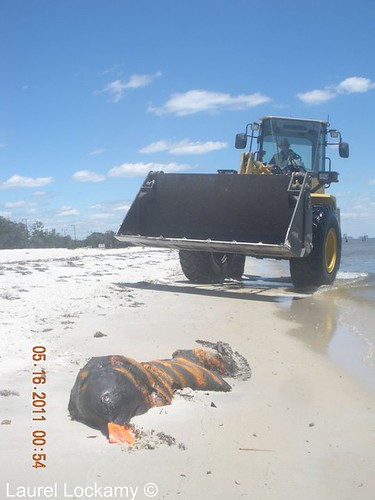A Stroll on a Gulf Beach Yields a Dolphin Disposal
Laurel Lockamy has seen her share of dead sea life washing up on the beaches of Mississippi. Like a few other residents, she’s toted her camera along wherever she goes, documenting the dolphins, sea turtles, red fish and plethora of dead birds that seem to be washing in unusually high numbers.
That isn't stopping Gulf businesses from hoping for a better year than last, when beaches were soaked in oil and tourism vanished with the black tide. Now there are signs business is rebounding. Tourist industries in Florida panhandle report better than expected traffic this year. Some in Congress in fact are pushing for increased drilling in the Gulf, with fewer safety and environmental reviews of the process. It seems some lawmakers have short memories.
But not all is well in the Gulf. High numbers of endangered sea turtles and dolphins have washed into the beaches, although the number of fatalities is declining. Scientists still don’t know what has caused this spike in deaths.
And they are still dying. Last Sunday, Laurel decided to take a stroll down the Gulfport beach after watching a boat race in nearby Biloxi. Off in the distance she saw a familiar orange-colored figure lying by the water’s edge. It was another dead dolphin, the third one she’s seen this year.
As she approached she realized it was a juvenile, maybe three or four feet long, badly decomposed. Someone had spray painted IMMS in bright orange on its side. That means Institute for Marine Mammal Research investigators had been there and counted it. A tag was stuck in its mouth with the date: May 13, 2011. That was two days earlier.

Dolphin carcass, Gulfport MS Photo: Laurel Lockamy
“At first I could not believe what I was seeing,” Laurel says. “It looked like an alligator with a long tail. Then I got really angry. The smell was so bad, it was heartbreaking.”
The next day Laurel slept late and went out to see if the dolphin was still there. It was. But just as she was taking more pictures, a large yellow bull dozier came roaring up the beach toward her. The driver sort of winked at her, she says, then proceeded to move the giant front loader bucket into position to snatch the decaying dolphin carcass from the water's edge.
As it wheeled closer to the orange-painted dolphin, Laurel stood her ground. She continued taking pictures as the tractor rolled along the shoreline and quickly scooped up a batch of sand along with the dolphin carcass. With his sandy catch held up in the air, the driver gunned his engines and rolled down the beach to a less populated area. Laurel watched in amazement as the front loader turned and dumped its load behind some beach vegetation. Poof it was gone! A instant sandy sarcophagus for another federally protected mammal. Perhaps no one else will ever know it’s there.
But Laurel does.
“It really gets to you,” she says. “All these dead things on the beach. It never used to be like this before. I’m almost afraid to walk on the beach anymore.”


Tractor takes dolphin off for disposal on Gulfport beach. Photos: Laurel Lockamy
Most people who go to the Gulf probably don’t have experiences like these. Or if they do, they may be willfully unaware. Laurel and others have taken many photos of children swimming and playing on beaches near dead turtles, dolphins and giant fish and birds that wash ashore. They wonder how some parents could not care.
Perhaps this is normal to some Gulf residents. But statistics for turtles and dolphins show it’s not. A year after the country greatest oil blowout there are still many unanswered questions about how 170 million gallons of oil and chemical dispersants are impacting one of the richest marine environments in the world.
We may never know for certain whether the demise of the dolphin buried beneath the sand in Gulfport was directly linked to the BP oil catastrophe. It’s unlikely scientists will ever say for sure. But we owe it to that dolphin--and all of the other marine life that has perished over the past year--that researchers keep trying to find out.
